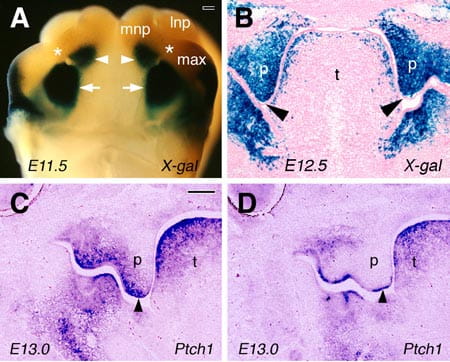Molecular Mechanisms of Palate Development
Development of the mammalian palate involves multiple steps of highly coordinated morphogenetic processes, including initiation and outgrowth of the palatal shelves from the oral side of the paired embryonic maxillary prominences, reorientation of palatal shelves to above the tongue, fusion of the palatal shelves at the midline and subsequent osteogenesis to form the intact roof of the oral cavity. These developmental processes are frequently disturbed during human development, resulting in the common birth defect of cleft palate.
Palatal growth depends on reciprocal interactions between the oral ectoderm and the underlying neural crest derived mesenchyme. To understand the molecular mechanisms regulating palate development, we looked for transcription factors specifically activated at the onset of palatal outgrowth. We identified the Osr2 (Odd-skipped related-2) zinc finger transcription factor as a key regulator of palatal outgrowth through generation and analyses of gene-knockout mice. Using the Osr2 gene as a tool, we have generated mice with specific Cre DNA recombinase expression in the developing palatal mesenchyme. Using Cre / loxP-mediated tissue-specific gene inactivation strategies, we have been dissecting the molecular network involving Bmp, Shh and Wnt signaling in the regulation of palate morphogenesis.
In addition, we have generated mice carrying either null or conditional mutations in the Pax9 gene, which encodes another transcription factor required for palate morphogenesis. Currently, we are using a combination of tissue-specific genetic studies and RNAseq, ChIP-seq approaches to unravel the gene regulatory network involving these transcription factors in palate development. We are also investigating how Osr2 and Pax9 interact with the different signaling pathways to pattern the developing palate. Data from these studies will be directly applicable for understanding cleft palate pathogenesis in humans




